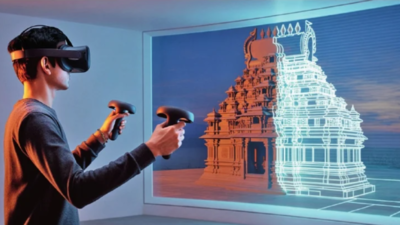
India must use technology to preserve and promote its heritage. Prof Neeru Misra,former ICCR director, visiting professor, Culture, Heritage & Museums, BL Institute of Indology, Delhi, on use of new technology to ensure longevity of cultural legacy, connecting past and future generations while addressing the complexities inherent in digital preservation. Excerpts of the interview:How can digital technology and AI preserve cultural heritage and art history for future generations?The integration of digital technology and Artificial Intelligence (AI) will be transformative in preserving cultural heritage and the history of art.
Digitisation will safeguard artefacts through high-resolution imaging, 3D modelling, to create resilient digital archives. This will protect physical degradation and ensure global accessibility, facilitating scholarly research and public appreciation.Also read: Why consensus on AI in higher education is important, and imminentAI advances preservation by analysing environmental factors that affect artefact deterioration, predicting potential damage, and enable precise restoration.
Furthermore, it reconstructs lost or fragmented works based on historical data, ensuring fidelity of the original creations. Virtual and Augmented Reality (VR and AR) complement these efforts by offering immersive experiences of historical sites and artefacts, democratising access to cultural heritage.Is India prepared for technological revolution to create interactive virtual guides and personalised tours, predictive maintenance and sentiment analysis for people who cannot personally visit museums, heri-tage sites and historical places?India is home to a vast array of historical landmarks and cultural treasures but faces the challenge of leveraging advanced technologies to make heritage accessible.
AR/VR promise significant benefits, including interactive virtual tours, predictive maintenance of sites, and sentiment analysis for enhanced visitor engagement. While these advancements can democratise access to heritage, their implementation in India remains nascent.Current initiatives include virtual exhibits of Ajanta caves at the National Museum, VR recreations of Ellora caves, and private efforts showcasing Rajasthan forts by Archaeological Survey of India (ASI).
But, limited technological infrastructure, funding, skill shortages, and the digital divide hinder its adoption. Strategic investments in infrastructure, government funding, partnerships with tech firms, and training s are essential to overcome these barriers.The students of History and Museology need to upgrade their technical skills to prepare for advancing industry demands and job market. Should the curriculum be tweaked?Adapting academic curricula to meet the evolving market demand is imperative for students. Integrating technical proficiency, interdisciplinary collaboration, and practical training create a robust foundation for career readiness.
A pivotal inclusion is digital tools, such as Geographic Information System (GIS), virtual reality applications, and database management systems essential for modern archival practices and presentation of cultural heritage.
Quantitative historical analysis and digital humanities can nurture critical thinking and data literacy. Interdisciplinary electives, spanning fields like anthropology and conservation science, enhance collaborative competencies, while modules on grant writing, marketing strategies prepare students navigate financial and managerial challenges.Can AI be used to enhance experiential learning and accurate assessment by the professors?AI holds transformative potential to introduce innovative pedagogical models. Experiential learning benefits from AI-driven simulations and virtual environments, enabling students to engage in practical, riskfree scenarios such as virtual surgeries or engineering designs. In pedagogical innovation, AI facilitates gamification, blending engagement with skill acquisition. Collaborative AI-powered platforms enable effective interdisciplinary teamwork through role-based task assignments.
For assessments, AI enhances accuracy through automated grading systems, holistic performance analysis, and predictive analytics, guiding professors to adopt proactive teaching strategies. Universities can incorporate AI by developing robust digital infrastructures, training faculty in AI applications, and establishing ethical frameworks to ensure data security and algorithmic fairness.Ethics in AI is a challenging requirement. How can students acquire credible information about history to control fake news?
Technology helps address critical challenges such as historical misinformation and regulating fake news. AI tools, such as advanced fact-checking systems, can cross-check historical claims with verified sources to ensure accuracy. AR-VR enables immersive engagement with historical events, allowing students to experience key moments authentically. Digital libraries enhance accessibility to primary sources, promoting in-depth understanding of history.
Addressing fake news requires AI-driven solutions such as real-time content verification and natural language processing to detect misinformation patterns.

 14 hours ago
54
14 hours ago
54




























 English (US)
English (US)